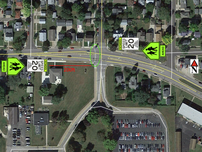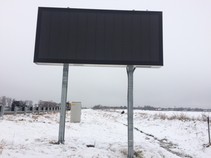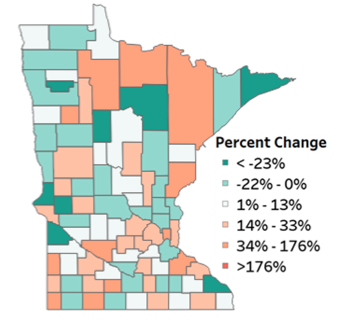|
|
|
|

Research is lacking about the best use of rectangular rapid-flashing beacons (RRFBs) and High-Intensity Activated crossWalK beacons (HAWKs), and their effectiveness in reducing pedestrian-vehicle accidents.
To provide more guidance on these common pedestrian-activated crossing types, MnDOT-sponsored researchers recorded months’ worth of intersection activity.
Thousands of hours of video footage revealed the following tendencies in pedestrian waiting behavior and driver yield rates:
- Pedestrians are generally more likely to activate crossings at locations with a higher number of lanes.
- Pedestrian crossing times are shorter at RRFBs than at HAWKs.
- Drivers generally yield well at activated crossings, though the delay times and long sequences of flashing and solid yellow and red lights at HAWKs may encourage lower yield rates and longer crossing time delays.
The research suggests that at RRFB sites with poor yield rates, replacement with a HAWK or overhead light system may improve driver behavior.
Visit the project page to learn more.
|

Research showed that dynamic message signs (DMS) with breakaway components handle wind-induced vibrations adequately for a 23.8-year fatigue life. The roadside installations remain an economical alternative to overhead DMS. Rural intersection conflict warning signs (RICWS) vibrate noticeably under wind forces. The breakaway base sleeves diminish post stiffness, and the signs are not heavy enough to manage wind stresses well. MnDOT is considering using a single tube of steel or aluminum for support posts.
Visit the project page to learn more.
|

A new guidebook developed by the Minnesota Local Road Research Board provides a uniform approach to identifying locations for uncontrolled pedestrian crosswalks and installing them.
The Uncontrolled Pedestrian Crosswalk: Quick Reference Guide provides information on 12 crosswalk treatments, including crosswalk warning signs, raised crosswalks, in-street signs, curb extensions and rapid-flashing beacons. A fact-sheet for each treatment describe safety and design benefits, best locations, design considerations and planning-level costs.
Additional charts helps decision-makers select choose the best treatment based on roadway type, vehicle volumes and posted speed limits.
Visit the project page to learn more.
|

Bonded concrete overlay of asphalt (BCOA) pavements, also known as whitetopping, can help enhance the structural capacity and rideability of existing asphalt pavements. Over the past decade, the popularity of BCOA pavements has grown in many states and many of these projects are now reaching an age where rehab is needed.
The National Road Research Alliance (NRRA), a new multi-state research fund led by the MnDOT Office of Materials & Road Research, has compiled a synthesis of current practices of BOCA repairs being used by different state agencies.
The survey found that most common type of repair is to conduct a full-depth removal and replacement of the concrete panels when the area of distresses is localized. This rehabilitation method is more cost-effective than others, the synthesis concluded, because of how thin BCOA pavements are.
The synthesis is the first report published by the NRRA. Three other reports were also recently published by NRRA research teams: Asphalt Mix Rejuvenators Synthesis, Service Life Enhancement of Substrates Overlaid with Thin Overlays (UTBWC, Chip Seals, and Micro-Surfacing) and Spray on Rejuvenator Synthesis
|

Federal and state funding for transportation projects has not kept up with roadway demands in recent years. Local governments have been shouldering more of the burden. This project examined the extent and effects of local agency contributions and collaborative projects that have included nonlocal features. Results include a set of recommendations that will allow local officials to better understand and more closely follow cooperative agreement requirements and procedures, promoting better decision-making for all involved.
This map of Minnesota shows the percent change in local roadway project funding by
county from 2008 through 2012 and from 2013 through 2017. While a few counties show a steady rate or decrease in local funding, many show an increase of 14% to more than 176%.
Visit the project page to learn more.
|
|
|
|
|